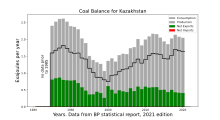Energy in Kazakhstan
[9] Also in 2015, Kazakhstan Investment and Development Minister announced that the country would establish a special fund engaged in financing energy-saving programs.[9] In 2016, Kazakhstan significantly increased the installed capacity of renewable energy facilities, which totaled 251.55 megawatts.The offshore fields of Kashagan and Kurmanagazy in the Caspian Sea are estimated to hold minimum 14 million barrels.To continue expanding the liquids production above its current levels, the country needs to develop its Tengiz, Karachaganak, and Kashagan fields as well as add export capacity.The oil production development has been made possible largely due to significant foreign investment, primarily from the Netherlands and the US in the early 2000s.[21] The government views the oil and gas sector as strategically important for the economy and the share of state involvement in the management over petroleum resources remains high.The landmark foreign investment in Kazakh oil industry is the TengizChevroil joint venture, owned 50% by ChevronTexaco, 25% by ExxonMobil, 20% by the Government of Kazakhstan, and 5% by Lukarco of Russia.Kazakhstan serves as a major transit country for gas exports from Turkmenistan and Uzbekistan that are destined to Russia and China.[12] Kazakhstan's domestic hydrocarbon reserves amount to 3.3–3.7 trillion cubic metres of gas, of which 2.5 tcm are proven.[28] The major natural gas fields are Karachaganak, Tengiz, Kashagan, Amangeldy, Zhanazhol, Urikhtau and Chinarevskoye.The top hard coal net exporters in 2009 were (Mt): Australia 262, Indonesia 230, Russia 93, Colombia 69, South Africa 67, United States 33, Vietnam 25, Kazakhstan 22, Canada 20 and Czech Republic 4.[21] Kazakhstan has a strategic geographical location to control oil and gas flows from Central Asia to East (China) and West (Russia, EU, global market).[48] In June 2003, the government of Kazakhstan announced a new Caspian Sea development program, according to which new offshore blocks of oil and gas to be auctioned.In 2005, the government introduced new restrictions granting to the state-owned oil and gas company KazMunayGas status of contractor and at least half of any production sharing agreement (PSA).The amendment raised the government's share of oil income to a range of 65-85%.The new structure includes an excess profit tax, and limits foreign participation to 50 percent in each offshore project with no guarantees of operatorship.Adopted by Prime Minister Serik Akhmetov, this new law would help reduce emissions and help with energy efficient solutions from large companies to small families.[49] The idea of building a nuclear power plant gained great prominence among the Government members during the early 2020s.[54] Kazatomprom also represents Kazakhstan in the joint ventures with Russian Tekhsnabexport, French AREVA and Canadian Cameco.The bank would be a place for countries to contribute uranium and disperse it to other nations safely for energy means with the IAEA being the governing body."[59] Kazakhstan announced in January 2017 that the country was planning to cut its production of uranium by 10% due to a global oversupply of the commodity.A planned 100 MW wind farm, one of the largest in Central Asia, is expected to be constructed in 2020 in Zhanatas with funding support from the Asian Infrastructure Investment Bank.[30] In general, various international organizations have played an important role in advising and assisting Kazakhstan's government in its energy sector reform and natural resource management.[11] Kazakhstan signed the European Energy Charter on December 17, 1991, the nation's first day of independence from the former Soviet Union.[65] On 4 December 2006, Kazakhstan and the European Union signed a Memorandum of Understanding (MoU), which sets the framework for deeper energy cooperation.On 3 October 2006 during the presidents' meeting in Oral, Kazakhstan and Russia agreed to set up a gas-condensate-processing joint venture between Gazprom and KazMunayGas in Orenburg, which will be supplied from the Karachaganak field.[69] On 10 May 2007, Russia and Kazakhstan agreed to set up an international uranium enrichment center in Angarsk, East Siberia.[citation needed] On 12 May 2007, Vladimir Putin of Russia, Nursultan Nazarbayev of Kazakhstan and Gurbanguly Berdimuhamedow of Turkmenistan signed an agreement providing for Central Asian gas to be exported to Europe through the reconstructed and expanded western branch of the Central Asia-Center gas pipeline system.I hope that all parties will now work to ensure that this increase in transparency will lead to reform in the management of the extractive industries, bringing real benefits to the people of Kazakhstan and providing leadership in other countries in the region.”[73] Kazakhstan and the International Atomic Energy Agency (IAEA) cooperated on several projects related to nuclear energy, agriculture, nuclear security, research, and others.[74] On August 27, 2015, an agreement to locate the IAEA LEU Bank in Kazakhstan was signed in the country's capital Astana.



energyelectricityKazakhstanpolitics of Kazakhstanits renewable energy sourcesTengizKarachaganakKashaganKazMunayGasKazakh governmentAtyrauShymkentPavlodarChevronKashagan oil fieldTengiz fieldKarachaganak fieldKashagan fieldKurmangazy fieldTengizChevroilChevronTexacoExxonMobilKarachaganak natural gas and gas condensate fieldLukoilIndianKoreanTürkmenabatTurkmenistanKarachanganakCentral Asia – China pipelineZhanazholKazMunaiGaSBogatyrBogatyr Coalhard coalbrown coalAustraliaIndonesiaRussiaColombiaSouth AfricaUnited StatesVietnamCanadaCzech RepublicUkraineBogatyr Access KomirBitcoinNursultan Nazarbayevenergy securityCentral AsiaINOGATEenergy marketsEU internal energy marketsustainable energyinvestmentan economy-wide carbon emissions systemCaspian Seaproduction sharing agreementsubsoilSerik Akhmetovnuclear power plantKassym-Jomart TokayevreferendumÜlkenJambyl DistrictAlmaty Regionuranium productionuranium reservesKazatompromTekhsnabexportFrenchCanadianCamecoLake BalkashKyzylordauraniumYukiya Amanonuclear non-proliferationHillary ClintonForeign MinisterErlan IdrissovEkibastuzIrtysh Riverrenewable energy resourcesZhanatasAsian Infrastructure Investment BankNuclear power in Kazakhstannuclear powernuclear reactornuclear plantCaspian Pipeline ConsortiumKazakhstan-China oil pipelineBaku-Tbilisi-Ceyhan pipelineCentral Asia-Center gas pipeline systemUzbekistanKyrgyzstanBukhara-Tashkent-Bishkek-Almaty pipelineOrenburgnatural gas pipeline to ChinaEuropean UnionGazpromBaktykozha IzmukhambetovRussian Federal Atomic Energy AgencySergei KiriyenkoMoukhtar DzhakishevVladimir Smirnovnuclear power plantsAngarskVladimir PutinGurbanguly BerdimuhamedowExtractive Industries Transparency InitiativeAstanalight-water reactorWayback MachineOxford Institute for Energy StudiesInternational Energy AgencyRadio Free EuropeWorld Nuclear AssociationNew Europe (Belgium)ForbesEnergy in Asia Sovereign statesAfghanistanArmeniaAzerbaijan